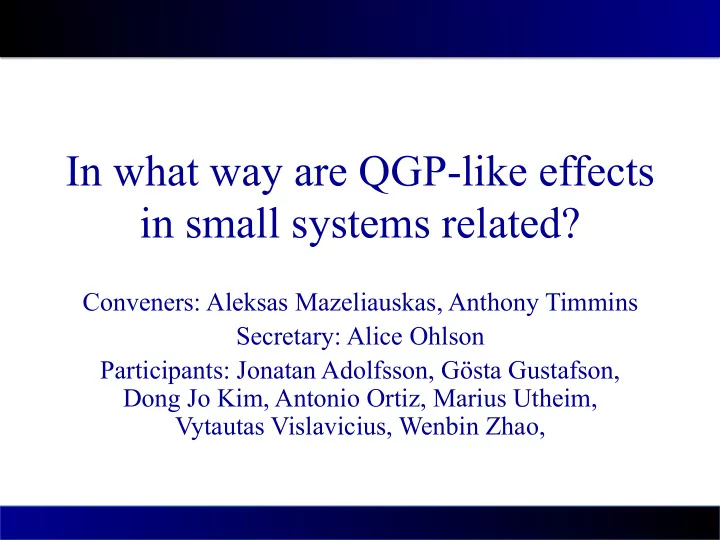

In what way are QGP-like effects in small systems related? Conveners: Aleksas Mazeliauskas, Anthony Timmins Secretary: Alice Ohlson Participants: Jonatan Adolfsson, Gösta Gustafson, Dong Jo Kim, Antonio Ortiz, Marius Utheim, Vytautas Vislavicius, Wenbin Zhao,
Anisotropic flow in small systems • Compelling evidence that final state anisotropy is driven by initial state geometry
Anisotropic flow in small systems • Compelling evidence that final state anisotropy is driven by initial state geometry • What mechanism converts the initial anisotropy to the final state momentum-space?
Anisotropic flow in small systems • Several mechanisms can produce flow-like effects – becomes a quantitative question: can all these models reproduce the PID-, multiplicity-, and pt- dependence of v n (and higher-order {v n ,v m } correlations) seen in the data?
Anisotropic flow in small systems • Several mechanisms can produce flow-like effects • Are kinetic observables the best ones for discriminating between medium + string-based pictures? What other observables would be more sensitive?
Strangeness enhancement • Can the distribution of strange quark production in phase space tell us about the mechanism? • Hypothesis: String-breaking → local correlations, medium → global production
Flow vs jet quenching • In heavy-ion collisions, anisotropic flow and high-p T yield suppression were viewed as two sides of a coin • But in p+A collisions we see v n > 0 with no suppression – (the comparison of light hadron v n is challenging because the p T ranges don’t always overlap)
Flow vs jet quenching • In heavy-ion collisions, anisotropic flow and high-p T yield suppression were viewed as two sides of a coin • But in p+A collisions we see v n > 0 with no suppression – clearly seen for heavy quarks (low-p T hard probes) – not understood
Heavy flavor flow & quenching • Hydro+transport model predicts D 0 flow with mild suppression of R AA – again a quantitative question: how big of an effect do we expect, compared to our experimental uncertainties? – need a similar calculation for light hadrons!
Recommend
More recommend